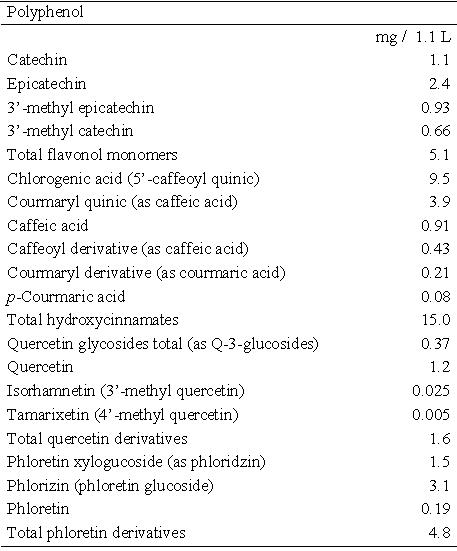Red wine has attracted a lot of attention from nutritional researchers because evidence is mounting that it has favourable effects on cardiovascular health. Red wine is thought to be beneficial because it contains high levels of grape polyphenols such as resveratrol. In addition, red wine contains ethanol which research has shown to confer health benefits to those who consume moderate amounts regularly. However, while wine has been extensively researched and the effects reported in the media, other alcoholic fruit beverages have not received the same level of interest. Cider is one such alcoholic drink that has the potential to benefit the health of drinkers because like red wine, it contains fruit polyphenols and ethanol. In the case of cider, the polyphenols are derived from apples. Apples are known to contain a number of polyphenols including flavon-3-ols (catechins), flavonols and hydroxycinnamic acids.
To determine the polyphenols metabolism in alcoholic cider, researchers from the Institute of Food Research1 measured the polyphenol content of plasma and urine of six subjects. The plasma of the subjects showed a wide variation in content suggesting biochemical individuality in the absorption and metabolism of apple cider polyphenols. Methylated forms of the flavonol quercetin [isorhamnetin (3’-methyl quercetin) and tamarixetin (4’-methyl quercetin)] were detected in plasma, but quercetin itself was not. The hydroxycinnamic acid, caffeic acids, was also present in plasma in the form of a rapid peak at 90 min, but no chlorogenic acid was detected. The urine of subjects contained the phenolic acid hippuric acid, and phloretin, with only very small amounts of epicatechin. No quercetin, methylated quercetin, or other flavon-3-ol compounds were detected in the urine. The cider was also analysed for polyphenol content for comparison (figure 1).
Figure 1. Polyphenols detected in cider.
Hippuric acid can be produced by natural catecholamine breakdown or through bacterial degradation of polyphenols followed by hepatic conjugation with glycine. Hippuric acid in the urine is not therefore a reliable marker of polyphenol excretion. However, phloretin (as phloretin glycosides) is found almost exclusively in apple skins. Its absence from pre-study urine, but its presence in the urine of subjects after consumption of apple cider does indeed suggest that the apple polyphenols were absorbed and excreted. Studies do suggest that cider confers some health benefits on those who consume moderate amount regularly, although the effect is possibly smaller than for that of red wine. While all alcoholic beverages should be moderated because of the potential damaging effects of ethanol, it would appear that apple cider is an effective way to increase intake of polyphenols while also benefiting from the health benefits of ethanol.
RdB

